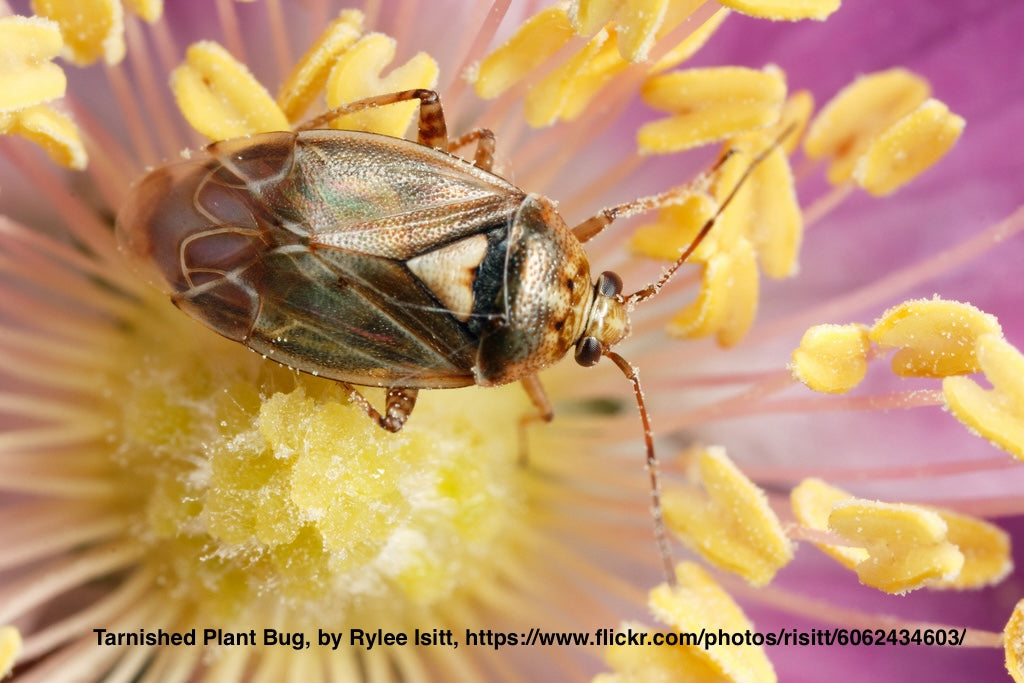Lygus, The Tarnished Plant Bug

We're not lyin' when we say that Lygus is trouble! The tarnished plant bug is a threat to over half of cultivated crops in North America, including soft fruits, berries, orchard fruit, veggies, flowers, seed production and even conifer seedlings. Lacewing larvae can impact the younger life stages.
After a winter of hiding out under dead leaves and rocks, Lygus emerges in the spring to begin feeding. It's attracted to many weeds, alfalfa and legumes. As they suck out plant juices, they secrete a toxic substance that kills plant cells, causing brown spots or misshapen fruit. Terminal shoots and flowers may also be destroyed.

The tarnished plant bug is around 5mm long with brown, tan and green colors. The nymphs are bright green and also feed on plants throughout their development which lasts over 3-4 weeks. The females lay eggs in protected spaces of leaf petioles and leaf blades making them hard to target with an insecticide. There can be 2-3 generations a year so it's important to slow down that first generation!

One of the most effective ways to do this is to remove weeds and any plant debris around your crops. This will reduce the overwintering populations and stop the spread. Always monitor plants in early spring and identify the pest.
Correct identification goes for all crops and all pests. Knowing what you are up against is critical for control options. Use University websites and extension agents to help with insect ID. Look-alikes for the tarnished plant bug are other plant bugs, seed bugs, false chinch bugs and the big-eyed bug (which is beneficial!)
For instance, knowing the difference between a beetle with a damaging soil-dwelling larval stage and the tarnished plant bug will help you decide whether to use beneficial nematodes or not. Yes for beetle grubs, no for Lygus.
Scouting for pests in the spring will help you keep track of their populations in your fields. Keep a record of this over the seasons as this will also help with planning and pest management. Yellow sticky traps can help scouting for pests. Look for wounds, discoloration and malformed fruit on susceptible crops. Trap the pest with a specially designed lure for Lygus.
Consider floating row covers over low-growing crops to provide a physical barrier to incoming plant bugs. Avoid planting crops that are favorable to Lygus, such as strawberries, close to clover or alfalfa, as the plant bugs can swoop in for the kill, being nearby.
After removing weeds and debris and scouting in the spring, you may still have too many pests and have reached an economic threshold. Several natural pesticides can be quite effective.
Azadiractin or neem oils act as insect growth regulators, antifeedants and ovipositional deterrents. These include Azaguard and Molt-X.
Mycoinsecticides containing entomopathogenic fungal spores. These include Botanigard, Mycotrol, NoFly, Bioceres and PFR 97.
Oils and soaps can be effective. Circadian Sunrise is a corn/peppermint oil that suffocates insects. M-Pede insecticidal soap and Suffoil-X are more options.
Grandevo is a broad spectrum bioinsecticide containing Chromobacterium labeled to target Lygus.
For a quick knockdown, use Pyganic with Pyrethrins which are derived from Chrysanthemums. Surround WP is another option. This contains kaolin clay which acts as a mechanical barrier, irritant and disrupts the beetle’s ability to find host plants.
A natural enemy of Lygus, the parasitic wasp Peristenus digoneutis, was imported from France in the 1980's and released for control of Lygus in alfalfa crops in New Jersey. It has since spread throughout the Northeast. Common predators, such as ladybeetles, spined soldier bugs, spiders and insidious flower bugs also prey on nymphs so watch those pesticides applications and keep the good bugs alive!
Augmentative releases of Orius, the minute pirate bug, and green lacewing larvae, if timed correctly, can also have an impact on the nymph populations. Release weekly or as needed during the nymphal stages. Orius at .1/square foot and lacewing larvae 1-5 larvae/square foot.

Contact us at Sound Horticulture anytime for specific recommendations for your region. The future is not tarnished, but bright!

Comments on this post (1)
Hello. I’m not a farmer but I’m battling a type of beetle that seems to have no identification, therefore cannot ask for pro’s to come to the rescue. I live in central (almost direct central) part of the state of Kansas. I have a video of the adult along with at least 40 specimens saved in alcohol. The larvae are the problem. They jump and crawl. The adults are winged and fly. The larvae get on my skin and feed. They attach like a tick. I do not like telling that part because Ive been informed multiple times that beetles do not behave in this manner, however, that does not align with what’s happening in my home for the last year and a half. I’ve sent to state extension office, who lost my samples, and other entomologists who said it is a foreign grain beetle. Well , with all due respect for them, this beetle is not in any of my food or kitchen. I have multiple pics and vids. Can I please send to you for id? just one vid? Thanks for listening
— Dianna Morris